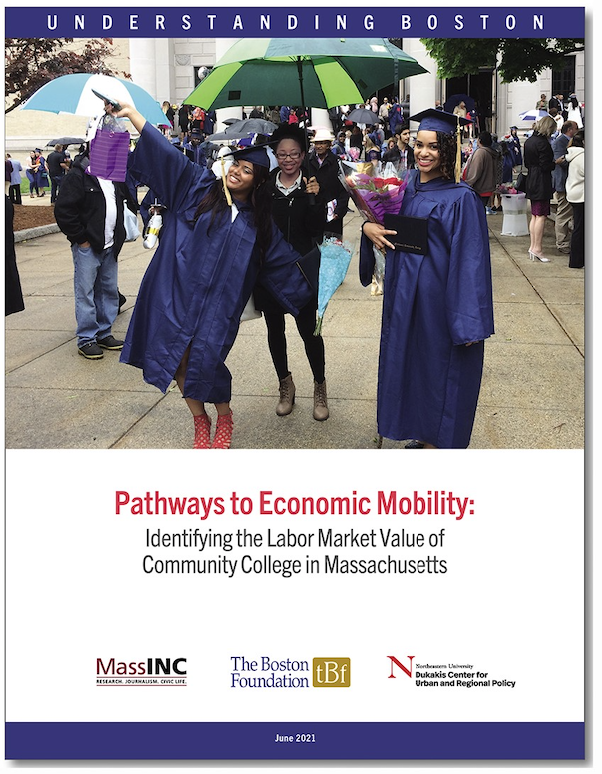Pathways to Economic Mobility: Identifying the Labor Market Value of Community College in Massachusetts
June 10, 2021
That’s the top-line takeaway from the latest Understanding Boston report from the Boston Foundation, Pathways to Economic Mobility: Identifying the Labor Market Value of Community College in Massachusetts. The report was presented and discussed at the first Foundation forum presented by new President and CEO M. Lee Pelton. He opened the event with gratitude for predecessor Paul Grogan’s legacy of public engagement and passion for community colleges, saying, “I am honored to be continuing that.” Affirming the Boston Foundation’s interest in continuous improvement and his philosophy that “excellence is not about being something but about becoming something,” he introduced the researchers to present the findings and an analysis of how to build on the good news.
Click here to view the the presentation slides.
Northeastern University’s Alicia Sasser Modestino and MassINC’s Benjamin Forman authored the report, and shared key points from the research that addressed these questions:
- What’s the payoff in terms of career and earnings for community college vs. a terminal high school diploma? and
- How does that payoff vary by different factors such as subject matter, student demographics or timing of enrolment?
They looked at outcomes for women, men, those who started right after high school, those who started one to five years later, different racial and ethnic groups, level of credential received, and areas of study. The nuances are presented in full in the report. To generalize, women with community college experience earn 15–20 percent more than their high-school-diploma-only peers, amounting to an additional $1,500–$8,000 per year. Men see a boost of $5,500–$9,000 per year, but only if they earn a credential—or if construction jobs are taken out of the equation. That remains a high-paying field for a terminal high school degree, and still predominantly male. Liberal arts concentrations have lower to no economic gains in immediate career/earnings outcomes but may be helpful for students transferring to four-year institutions—a rich field for future investigation but beyond the scope of the current study. Overall, there is a clear “dosage effect”: the greater the attendance, the greater the effects. The employment boost is higher for low-income, Black and Latinx students but their completion rates are lower than White students’.
That makes the pathway for policy advocacy clear: “We really have to get people across the finish line,” as Modestino put it. Forman outlined several approaches that have already been piloted, such as early college in high school, comprehensive coaching programs, funding for financial aid, and basic needs support. But more can be done or expanded to reform policy so that the current report’s findings can be a catalyst for change—even at the level of informing advisors’ career and academic advice to students.
The report presentation was followed by a lively discussion moderated by the Boston Foundation’s Antoniya Marinova among stakeholders in the community college system—from a graduate to a president, policy makers to employers.
From all these different vantage points, the strong findings in favor of community colleges were no surprise. As Bunker Hill Community College President Pam Eddinger put it, “The community college world has known this for years. But now we have specific local and regional data that show it. That’s gratifying. And also timely, as we work on recovery and how to get 400,000 unemployed people back to work.” With federal recovery money coming to the state, this report may help advocate for spending on community colleges.
Employers, for their part, are finding it worth their while to invest time and effort in cultivating community college students as interns and future employees. Both Dell (with its Massachusetts-based subsidiary EMC) and Ultragenyx Pharmaceutical have made partnering with community colleges a bigger part of their recruitment portfolios, going well beyond merely posting jobs or attending career fairs. They have ongoing internship and mentoring programs, do guest teaching stints, and update faculty and advisors on knowledge and skills they are looking for in recruits.
“Internships were key to where I am now,” said Bunker Hill grad and now KPMG Audit Associate Jorge Coto. Two internships with KPMG toward the end of his college career led to his hiring. He credits his success in graduating from UMass Amherst with a bachelor’s and a master’s in accounting to his start at community college, which helped him transition to college level academic demands before launching into the large university setting. He worked with a coach through that high school to college transition via Success Boston—a program that inspired Bunker Hill to change its entire advising model to a wraparound support approach.
PANELISTS
- Jorge Coto, Audit Associate, KPMG US
- Pam Eddinger, President, Bunker Hill Community College
- Wayne Epps, Talent Acquisition, Diversity Campus Manager, Dell Technologies
- Tom Lauzon, Vice President, Manufacturing, Ultragenyx Pharmaceutical
- Elena Quiroz-Livanis, Assistant Commissioner for Academic Policy & Student Success and Chief of Staff, Massachusetts Department of Higher Education
Elena Quiroz-Livanis from the Massachusetts Department of Higher Education acknowledged the system is not currently set up for universal success. The department is reviewing existing policies from A to Z to see whether they put up barriers—either intentionally or accidentally—for any populations of students. And she added another to the list of researchers’ future projects: a qualitative study to understand the barriers to persistence in higher ed.
As Paul Grogan wrote in his preface to the report: “What the researchers found is gratifying in showing the beneficial impact of community college on students’ subsequent careers, but we cannot rest on those laurels. …Our charge now is to make the acquisition of those credentials an accessible and reasonable goal for any who wish to take that path.”

